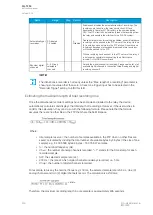
Once the configuration file has been loaded, the user can access the Modbus map of the relay via the
AQtivate software (
Tools
→
Communication
→
Modbusmap). Please note that holding registers start
from 1. Some masters might begin numbering holding register from 0 instead of 1; this will cause an
offset of 1 between the relay and the master.
Table. 6.1.2 - 160. Modbus/TCP settings.
Parameter
Range
Description
Enable Modbus/
TCP
0: Disabled
1: Enabled
Enables and disables the Modbus/TCP on the Ethernet port.
IP port
0…65 535
Defines the IP port used by Modbus/TCP. The standard port (and the default
setting) is 502.
Event read mode
0: Get oldest available
1: Continue previous
connection
2: New events only
0: Get oldest event possible (Default and current implementation)
1: Continue with the event idx from previous connection
2: Get only new events from connection time and forward
Table. 6.1.2 - 161. Modbus/RTU settings.
Parameter
Range
Description
Slave address
1…247
Defines the Modbus/RTU slave address for the unit.
Additionally, the user can adjust the measurement update interval with the following parameters (found
at
Measurement
→
Measurement update). These parameters do not affect the operating times of
protection functions, only the frequency of measurement reporting to Modbus.
Table. 6.1.2 - 162. Settings for measurement update interval.
Name
Range
Step Default
Description
Current measurement update
interval
500…10
000ms
5ms
2
000ms
Defines the measurement update interval of all current-
related measurements.
Voltage measurement update
interval
500…10
000ms
5ms
2
000ms
Defines the measurement update interval of all voltage-
related measurements.
Power measurement update
interval
500…10
000ms
5ms
2
000ms
Defines the measurement update interval of all power-related
measurements.
Impedance
measurement update interval
500…10
000ms
5ms
2
000ms
Defines the measurement update interval of all impedance-
related measurements.
6.1.3 Modbus I/O
The Modbus I/O protocol can be selected to communicate on the available serial ports. The Modbus I/
O is actually a Modbus/RTU master implementation that is dedicated to communicating with serial
Modbus/RTU slaves such as RTD input modules. Up to three (3) Modbus/RTU slaves can be
connected to the same bus polled by the Modbus I/O implementation. These are named I/O Module A,
I/O Module B and I/O Module C. Each of the modules can be configured using parameters in the
following two tables.
Table. 6.1.3 - 163. Module settings.
Name
Range
Description
I/O module X
address
0…247
Defines the Modbus unit address for the selected I/O Module (A, B, or C). If this setting
is set to "0", the selected module is not in use.
Module x
type
0: ADAM-4018+
1: ADAM-4015
Selects the module type.
A
AQ
Q-T256
-T256
Instruction manual
Version: 2.06
244
© Arcteq Relays Ltd
IM00028
Содержание AQ-T256
Страница 1: ...AQ T256 Transformer protection IED Instruction manual...
Страница 2: ......
Страница 264: ...Figure 7 3 120 Example block scheme A AQ Q T256 T256 Instruction manual Version 2 06 262 Arcteq Relays Ltd IM00028...
Страница 284: ...Figure 8 13 141 Device installation A AQ Q T256 T256 Instruction manual Version 2 06 282 Arcteq Relays Ltd IM00028...









































